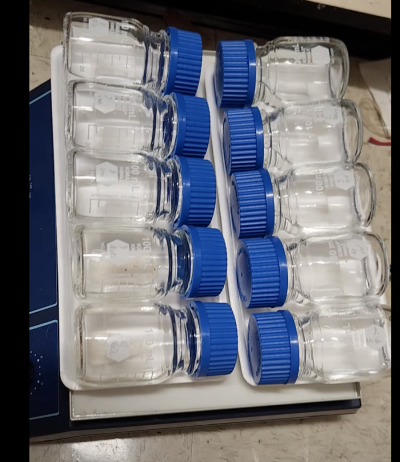- Joined
- May 22, 2016
- Messages
- 6,565
- Reaction score
- 10,145
(post 3 updated with procedure)
Procedure Part 1 - Ammonia only:
This - Part 1 - is meant to be pretty restrictive to clearly distinguish those sources with and without classic chemoautotrophic nitrifiers. Bacteria products that don't process ammonia under these conditions will have their particular needs met in subsequent parts. No food/organic carbon - including liquid media in bottle, no light nor substrate surfaces aside from the glass and water. All they get is moving saltwater, ammonia, O2, moderate temps and time.
Water is new Instant Ocean at 1.026 S.G. Stock solution is prepared from Ammonium Chloride. On day 0, 0.5ppm total ammonia is added - over the next 2-3 days, more stock is added to ramp up to 2.0ppm total ammonia added.
60 mL of the water is added to 100mL glass Kimax bottles (bottles will then have about 50mL of airspace - abundant O2 for these conditions). After inoculation, bottles are placed on their side on an orbital shaker at ~60rpm 24/7 in the dark.

Ambient temps are 72-78F. Bottles will be opened every 1-3 days and samples for chemical tests are taken with sterilized disposable pipette tips to avoid cross contamination. After sampling, bottles are shaken vigorously for ~3 seconds to aerate O2 to back near maximum or break up any surface films that might try to form.
For this part, since both random contamination and saltwater tank contamination do nothing to ammonia for ~a month - samples are not sterilized. All materials are simply washed in soap and water, and rinsed in tap + distilled like a hobbyist might do.
Inoculation:
The bottled bacteria products are vigorously shaken for 30 seconds before opening. They are then poured into 15mL centrifuge tubes and centrifuged at 4000 RPM for ~60 sec.
The media from the bottle is then poured off leaving the visible bacteria pellet behind. The pelleted bacteria are resuspended in the new mixed saltwater, and the bottles are then inoculated with the resuspended bacteria. The amount of bacteria added for all products will be 3x the minimum amount recommended (since some do not give a maximum amount recommended "pour the whole bottle".)
Sand products have their media removed similarly by being scooped into a beaker and the new saltwater is poured over and gently swirled around so the water moved but not the sand. The new saltwater is poured off and sand - enough to cover the bottom - is added to inoculate the bottles.
Measurements:
Total ammonia - modified API
Nitrite - API
pH - API
Will all be measured colorimetrically and values calculated from calibrations done on those test kits.
After nitrite is zero - either by being fully processed or none ever produced - Nitrate - hanna high range will be measured to compare to the expected NO3 from the Ammonia processed.
(Procedure Part 2 - fish food: ....later)
Procedure Part 1 - Ammonia only:
This - Part 1 - is meant to be pretty restrictive to clearly distinguish those sources with and without classic chemoautotrophic nitrifiers. Bacteria products that don't process ammonia under these conditions will have their particular needs met in subsequent parts. No food/organic carbon - including liquid media in bottle, no light nor substrate surfaces aside from the glass and water. All they get is moving saltwater, ammonia, O2, moderate temps and time.
Water is new Instant Ocean at 1.026 S.G. Stock solution is prepared from Ammonium Chloride. On day 0, 0.5ppm total ammonia is added - over the next 2-3 days, more stock is added to ramp up to 2.0ppm total ammonia added.
60 mL of the water is added to 100mL glass Kimax bottles (bottles will then have about 50mL of airspace - abundant O2 for these conditions). After inoculation, bottles are placed on their side on an orbital shaker at ~60rpm 24/7 in the dark.

Ambient temps are 72-78F. Bottles will be opened every 1-3 days and samples for chemical tests are taken with sterilized disposable pipette tips to avoid cross contamination. After sampling, bottles are shaken vigorously for ~3 seconds to aerate O2 to back near maximum or break up any surface films that might try to form.
For this part, since both random contamination and saltwater tank contamination do nothing to ammonia for ~a month - samples are not sterilized. All materials are simply washed in soap and water, and rinsed in tap + distilled like a hobbyist might do.
Inoculation:
The bottled bacteria products are vigorously shaken for 30 seconds before opening. They are then poured into 15mL centrifuge tubes and centrifuged at 4000 RPM for ~60 sec.
The media from the bottle is then poured off leaving the visible bacteria pellet behind. The pelleted bacteria are resuspended in the new mixed saltwater, and the bottles are then inoculated with the resuspended bacteria. The amount of bacteria added for all products will be 3x the minimum amount recommended (since some do not give a maximum amount recommended "pour the whole bottle".)
Sand products have their media removed similarly by being scooped into a beaker and the new saltwater is poured over and gently swirled around so the water moved but not the sand. The new saltwater is poured off and sand - enough to cover the bottom - is added to inoculate the bottles.
Measurements:
Total ammonia - modified API
Nitrite - API
pH - API
Will all be measured colorimetrically and values calculated from calibrations done on those test kits.
After nitrite is zero - either by being fully processed or none ever produced - Nitrate - hanna high range will be measured to compare to the expected NO3 from the Ammonia processed.
(Procedure Part 2 - fish food: ....later)


















